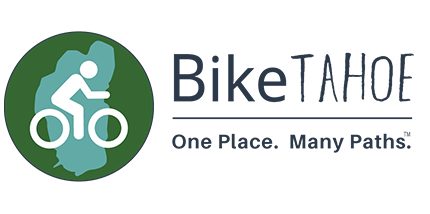Lake Tahoe Mountain Biking Tips & Resources

Lake Tahoe Mountain Biking: Know Before You Go
Know your equipment, your ability and the area you plan on riding. Be self-sufficient with supplies and tools to repair a flat tire, hydrate, and have a snack. Check with knowledgeable sources (local bike shop personnel, trail maps, local riders) before heading out onto a single track trail.
Ride On Open Trails Only
Respect trail and road closures (ask if uncertain); avoid trespassing on private land; obtain permits or other authorization as may be required. Federal Wilderness areas are closed to cycling. Riding on the Tahoe Rim Trail is open to cyclists on even date days.
Share the Trail
Designated mountain bike trails in Tahoe are multi-use trails in which hikers, equestrians and in some cases motorcycles and ATV’s may also use and enjoy. Let your fellow trail users know you’re coming. A friendly greeting or bell is considerate and works well. Anticipate other trail users around corners or in blind spots. Show your respect when passing others on the trail by slowing to a walking pace or even stopping. Yielding means slowing down, establishing communication, and being prepared to stop, if necessary, in order to safely pass.
When encountering horses always be prepared to dismount, yield the trail and allow the horse and rider to pass. Check in with the rider for advice on how they would like you to proceed. Speak to horses in soothing tones, and encourage equestrians to stay on the trail. Black Bears are numerous in Tahoe and it is not uncommon to see them. Never feed them or antagonize them. When encountering a bear stay still.
Leave No Trace.
Be sensitive to the land beneath you. Practice low-impact cycling. Recognize different types of soils and trail construction. Wet and muddy trails are more vulnerable to damage and erosion. Avoid locking your brakes and skidding as this damage the trail. Don’t cut switchbacks. Be sure to pack out at least as much debris as you packed in.
Know Your Place in Space
Once at the trailhead look around and get your bearings where you are and orient yourself to specific topographical features – like mountain peaks, valleys, creeks, lakes, and even buildings and neighborhoods. These features can continually provide reference points as you navigate your way during a ride.
Keep in mind that riding in Tahoe is like riding in a giant bowl. One can get disoriented climbing to elevation to get those high scenic vistas or traversing cross county to get from location. So keep in mind that gravity will always draw you down hill and eventually cross a road to help you return to your intended destination.
Take Time to Hydrate
Drinking water is essential in the high altitude to minimize the risk of fatigue, dehydration and cramping. The high elevation, low humidity and hot dry temperatures during the summer months can contribute to dehydration, fatigue, faintness, dizziness, headache and nausea – similar symptoms associated with Altitude Sickness.
Take plenty of drinking water with you – either water bottles or water packs work well. It is strongly recommended that you do not drink water from the streams and lakes as many of them may have Giardia – an amoeba that can cause abdominal pain, cramps, nausea and diarrhea.
Buddy System
The potential for unforeseen events to happen while riding is ever present. It is strongly recommended that you ride with a buddy whenever possible. And, when not possible that you either: tell someone where you will be riding or take a cell phone with you. If alone and needing assistance, dial 911.
